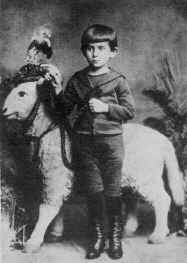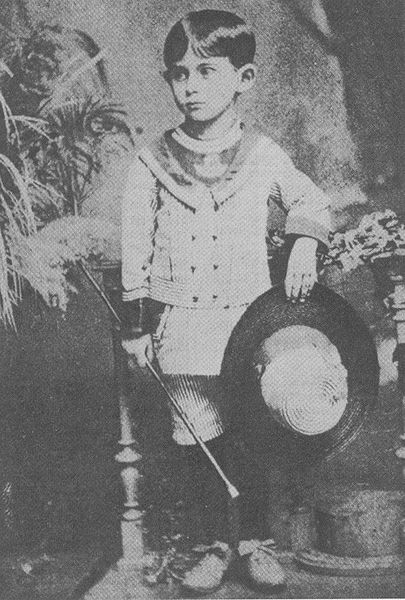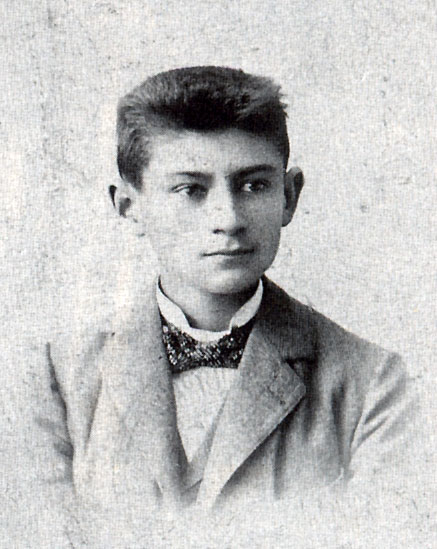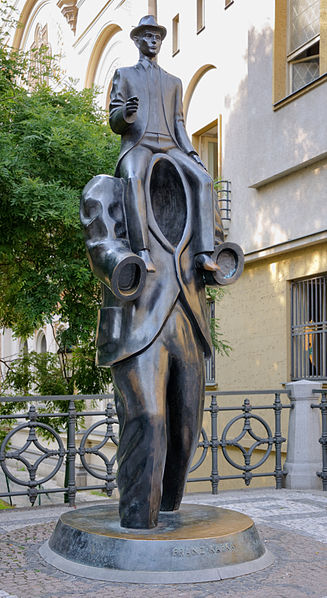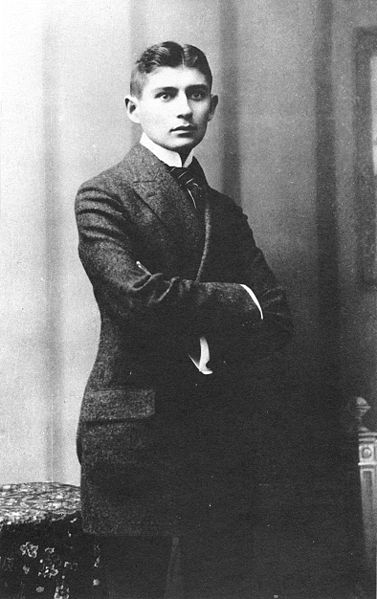<Back to Index>
- Writer Franz Kafka, 1883
PAGE SPONSOR
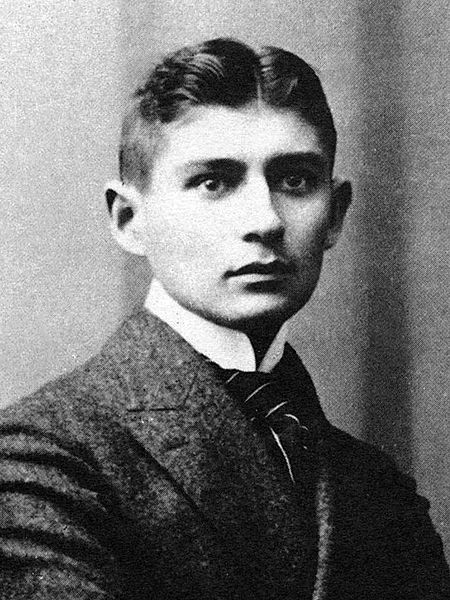
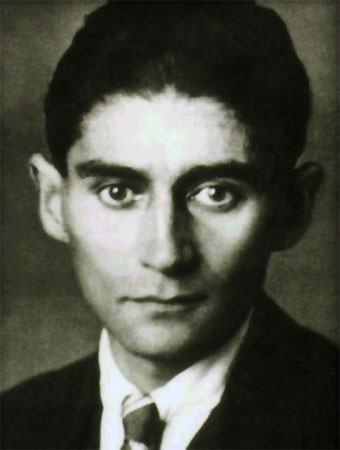
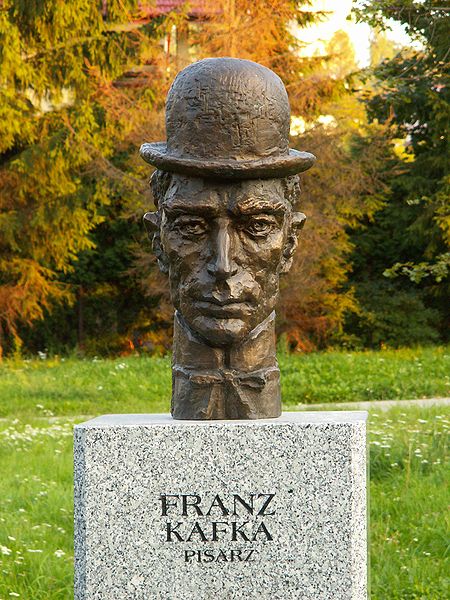
Franz Kafka (3 July 1883 – 3 June 1924) was a culturally influential German language author of short stories and novels. Contemporary critics and academics, including Vladimir Nabokov, regard Kafka as one of the best writers of the 20th century. The term "Kafkaesque" has become part of the English language.
Kafka was born to middle class German speaking Jewish parents in Prague, Bohemia, then part of the Austro - Hungarian Empire. The house in which he was born, on the Old Town Square next to Prague's Church of St Nicholas, now contains a permanent exhibition devoted to the author.
Most of Kafka's writing, including the large body of his unfinished work, was published posthumously.
Kafka was born into a middle class Ashkenazi Jewish family in Prague (now the Czech Republic). His father, Hermann Kafka (1852 – 1931), was described as a "huge, selfish, overbearing businessman" and by Kafka himself as "a true Kafka in strength, health, appetite, loudness of voice, eloquence, self - satisfaction, worldly dominance, endurance, presence of mind, [and] knowledge of human nature". Hermann was the fourth child of Jacob Kafka, a shochet or ritual slaughterer, and came to Prague from Osek, a Czech speaking Jewish village near Písek in southern Bohemia. After working as a traveling sales representative, he established himself as an independent retailer of men's and women's fancy goods and accessories, employing up to 15 people and using a jackdaw (kavka in Czech) as his business logo. Kafka's mother, Julie (1856 – 1934), was the daughter of Jakob Löwy, a prosperous brewer in Poděbrady, and was better educated than her husband.
Franz was the eldest of six children. He had two younger brothers: Georg and Heinrich, who died at the ages of fifteen months and seven months, respectively, before Franz was seven; and three younger sisters, Gabriele ("Elli") (1889 – 1944), Valerie ("Valli") (1890 – 1944) and Ottilie ("Ottla") (1892 – 1943). On business days, both parents were absent from the home. His mother helped to manage her husband's business and worked in it as many as 12 hours a day. The children were largely reared by a series of governesses and servants. Kafka's relationship with his father was severely troubled as explained in the Letter to His Father in which he complained of being profoundly affected by his father's authoritarian and demanding character.
During World War II, the Nazi Germans deported Kafka's sisters with their families to the Łódź Ghetto and they died there or in extermination camps. Ottla was sent to the concentration camp at Theresienstadt and then on 7 October 1943 to the death camp at Auschwitz.
Kafka's native language was German, in which he exclusively composed all his literary works. He was also fluent in Czech and took an interest in Czech literature. Later, Kafka acquired some knowledge of French language and culture; one of his favorite authors was Flaubert. From 1889 to 1893, he attended the Deutsche Knabenschule, the boys' elementary school at the Masný trh / Fleischmarkt (meat market), the street now known as Masná street. His Jewish education was limited to his Bar Mitzvah celebration at 13 and going to the synagogue four times a year with his father, which he loathed. After elementary school, he was admitted to the rigorous classics oriented state Gymnasium, Altstädter Deutsches Gymnasium, an academic secondary school with eight grade levels, where German was also the language of instruction, at Old Town Square, within the Kinsky Palace. He completed his Matura exams in 1901.
Admitted to the Charles - Ferdinand University of
Prague, Kafka first studied chemistry, but switched after two weeks to
law. This offered a range of career possibilities, which pleased his
father, and required a longer course of study that gave Kafka time to
take classes in German studies and art history. At the university, he
joined a student club, named "Lese- und Redehalle der Deutschen
Studenten", which organized literary events, readings and other activities. In the end of his first year of studies, he met Max Brod, who would become a close friend of his throughout his life, together with the journalist Felix Weltsch,
who also studied law. Kafka obtained the degree of Doctor of Law on 18
June 1906 and performed an obligatory year of unpaid service as law
clerk for the Civil and criminal courts.
On 1 November 1907, he was hired at the Assicurazioni Generali, a Italian insurance company, where he worked for nearly a year. His correspondence, during that period, witnesses that he was unhappy with his working time schedule — from 8 a.m. (8:00) until 6 p.m. (18:00) — as it made it extremely difficult for him to concentrate on his writing. On 15 July 1908, he resigned, and two weeks later found more congenial employment with the Worker's Accident Insurance Institute for the Kingdom of Bohemia. The job involved investigating personal injury to industrial workers, such as lost fingers or limbs, and assessing compensation. Industrial accidents of this kind were commonplace at this time. Management professor Peter Drucker credits Kafka with developing the first civilian hard hat while he was employed at the Worker's Accident Insurance Institute, but this is not supported by any document from his employer. His father often referred to his son's job as insurance officer as a "Brotberuf", literally "bread job", a job done only to pay the bills. While Kafka often claimed that he despised the job, he was a diligent and capable employee. He was also given the task of compiling and composing the annual report and was reportedly quite proud of the results, sending copies to friends and family. In parallel, Kafka was also committed to his literary work. Together with his close friends Max Brod and Felix Weltsch, these three were called "Der enge Prager Kreis", the close - knit Prague circle, which was part of a broader Prague Circle, "a loosely knit group of German - Jewish writers who contributed to the culturally fertile soil of Prague from the 1880s till after World War I."
In 1911, Karl Hermann, spouse of his sister Elli, asked Kafka to collaborate in the operation of an asbestos factory known as Prager Asbestwerke Hermann and Co. Kafka showed a positive attitude at first, dedicating much of his free time to the business. During that period, he also found interest and entertainment in the performances of Yiddish theater, despite the misgivings of even close friends such as Max Brod, who usually supported him in everything else. Those performances also served as a starting point for his growing relationship with Judaism.
Some sources have claimed that Kafka possessed a schizoid personality disorder – rather a rare type / trait according to some authors. His work, they claim, not only in The Metamorphosis,
but in various other writings, appear to show medium to low - level
schizoid characteristics which explain much of his surprising work. However, a study of Kafka's family and early life by psychoanalyst Alice Miller in her book Thou Shalt Not Be Aware offers
a different angle on the sources of Kafka's psychological anguish and
his expression of his painful early life in his writings.
In 1912, at Max Brod's home, Kafka met Felice Bauer, who lived in Berlin and worked as a representative for a dictaphone company. Over the next five years they corresponded a great deal, met occasionally, and were engaged twice. Their relationship finally ended in 1917.
That same year, Kafka began to suffer from tuberculosis, which required frequent convalescence during which he was supported by his family, most notably his sister Ottla. Despite his fear of being perceived as both physically and mentally repulsive, he impressed others with his boyish, neat and austere good looks, a quiet and cool demeanor, obvious intelligence and dry sense of humor.
From 1920 Kafka developed an intense relationship with Czech journalist and writer Milena Jesenská. In July 1923, throughout a vacation to Graal - Müritz on the Baltic Sea, he met Dora Diamant and briefly moved to Berlin in the hope of distancing himself from his family's influence to concentrate on his writing. In Berlin, he lived with Diamant, a 25 year old kindergarten teacher from an orthodox Jewish family, who was independent enough to have escaped her past in the ghetto. She became his lover, and influenced Kafka's interest in the Talmud.
Kafka's tuberculosis worsened and he returned to Prague. He went to Dr. Hoffmann's sanatorium in Kierling near Vienna for treatment, where he died on 3 June 1924, apparently from starvation. The condition of Kafka's throat made eating too painful for him, and since parenteral nutrition had not yet been developed, there was no way to feed him. He was age 40 years and 11 months. His body was ultimately brought back to Prague where he was buried on 11 June 1924, in the New Jewish Cemetery (sector 21, row 14, plot 33) in Prague - Žižkov.
Kafka attended meetings of the Klub Mladých, a Czech anarchist, anti - militarist and anti - clerical organization. Hugo
Bergmann, who attended both the same elementary and high schools as
Kafka, had a falling out with Kafka during their last academic year
(1900 – 1901) because "[Kafka's] socialism and my Zionism were
much too strident." "Franz became a socialist, I became a Zionist in
1898. The synthesis of Zionism and socialism did not yet exist."
Bergmann claims that Kafka openly wore a red carnation to school to show
his support for socialism. In one diary entry, Kafka made reference to influential anarchist philosopher Peter Kropotkin: "Don't forget Kropotkin!" He
later stated, regarding the Czech anarchists: "They all sought
thanklessly to realize human happiness. I understood them. But ... I was
unable to continue marching alongside them for long."
Kafka was well versed in Yiddish literature, and loved Yiddish theater.
In his essay, Sadness in Palestine?!, Dan Miron explores Kafka's connection to Zionism. "It seems that those who claim that there was such a connection and that Zionism played a central role in his life and literary work, and those who deny the connection altogether or dismiss its importance, are both wrong. The truth lies in some very elusive place between these two simplistic poles."
According to James Hawes, Kafka, though much aware of his own Jewishness, did not incorporate his Jewishness into his work. "There is zero actual Jewishness" nor any Jewish characters or specifically Jewish scenes in his work, says Hawes. In the opinion of literary critic Harold Bloom, author of The Western Canon, however, "Despite all his denials and beautiful evasions, [Kafka's writing] quite simply is Jewish writing." Lothar Kahn is likewise unequivocal: "The presence of Jewishness in Kafka's oeuvre is no longer subject to doubt." Pavel Eisner, one of Kafka's first translators, interprets the classic, The Trial, as the "triple dimension of Jewish existence in Prague is embodied in Kafka's The Trial: his protagonist Josef K. is (symbolically) arrested by a German (Rabensteiner), a Czech (Kullich) and a Jew (Kaminer). He stands for the "guiltless guilt" that imbues the Jew in the modern world, although there is no evidence that he himself is a Jew."
Livia
Rothkirchen calls Kafka the "symbolic figure of his era." His era
included numerous other Jewish writers (Czech, German and national Jews)
who were sensitive to German, Czech, Austrian and Jewish culture.
According to Rothkirchen, "This situation lent their writings a broad
cosmopolitan outlook and a quality of exaltation bordering on
transcendental metaphysical contemplation. An illustrious example is
Franz Kafka."
Kafka's writing attracted little attention until after his death. During his lifetime, he published only a few short stories. He finished the novella "The Metamorphosis", but never finished any of his full length novels. Kafka left his published and unpublished work to his friend and literary executor Max Brod with explicit instructions that it should be destroyed on his (Kafka's) death; Kafka wrote: "Dearest Max, my last request: Everything I leave behind me ... in the way of diaries, manuscripts, letters (my own and others'), sketches, and so on, [is] to be burned unread." Brod decided to ignore this request and went on to publish the novels and collected works between 1925 and 1935. The remaining papers were consigned to suitcases which he carried with him when he fled to Palestine in 1939. (His lover, Dora Diamant, also ignored his wishes, secretly keeping up to 20 notebooks and 35 letters until they were confiscated by the Gestapo in 1933. An ongoing international search is being conducted for these missing Kafka papers.) Brod, in fact, would oversee the publication of most of Kafka's work in his possession, which soon began to attract attention and high critical regard.
Max Brod encountered significant difficulty in compiling Kafka's notebooks into any chronological order as Kafka was known to start writing in the middle of notebooks, from the last page towards the first, etc.
All of Kafka's published works, except several letters he wrote in Czech to Milena Jesenská, were written in German.
Kafka often made extensive use of a characteristic peculiar to the German language allowing for long sentences that sometimes can span an entire page. Kafka's sentences then deliver an unexpected impact just before the full stop — that being the finalizing meaning and focus. This is achieved due to the construction of certain sentences in German which require that the verb be positioned at the end of the sentence. Such constructions are difficult to duplicate in English, so it is up to the resourceful translator to provide the reader with the same (or at least equivalent) effect found in the original text.
Another
virtually insurmountable problem facing translators is how to deal with
the author's intentional use of ambiguous terms and of words that have
several meanings. One such instance is found in the first sentence of The Metamorphosis. English translators have often sought to render the word Ungeziefer as "insect"; in Middle German, however, Ungeziefer literally means "unclean animal not suitable for sacrifice" and
is sometimes used colloquially to mean "bug" – a very general
term, unlike the scientific sounding "insect". Kafka had no intention of
labeling Gregor, the protagonist of the story, as any specific thing,
but instead wanted to convey Gregor's disgust at his transformation.
Another example is Kafka's use of the German noun Verkehr in the final sentence of The Judgment. Literally, Verkeh rmeans
intercourse and, as in English, can have either a sexual or non - sexual
meaning; in addition, it is used to mean transport or traffic. The
sentence can be translated as: "At that moment an unending stream of
traffic crossed over the bridge." What
gives added weight to the obvious double meaning of 'Verkehr' is
Kafka's confession to Max Brod that when he wrote that final line, he was thinking of "a violent ejaculation".
Critics have interpreted Kafka's works in the context of a variety of literary schools, such as modernism, magic realism and so on. The apparent hopelessness and absurdity that seem to permeate his works are considered emblematic of existentialism. Others have tried to locate a Marxist influence in his satirization of bureaucracy in pieces such as In the Penal Colony, The Trial and The Castle, whereas others point to anarchism as an inspiration for Kafka's anti - bureaucratic viewpoint. Still others have interpreted his works through the lens of Judaism (Borges made a few perceptive remarks in this regard), through Freudianism (because of his familial struggles), or as allegories of a metaphysical quest for God (Thomas Mann was a proponent of this theory).
Themes of alienation and persecution are repeatedly emphasized – and with good reason – but the over - emphasis on this quality, notably in the work of Marthe Robert, partly inspired the counter - criticism of Gilles Deleuze and Félix Guattari, who argued in Kafka: Toward a Minor Literature that there was much more to Kafka than the stereotype of a lonely figure writing out of anguish, and that his work was more deliberate, subversive and more "joyful" than it appears to be. Furthermore, an isolated reading of Kafka's work — focusing on the futility of his characters' struggling without the influence of any studies on Kafka's life — reveals the humor of Kafka. Kafka's work, in this sense, is not a written reflection of any of his own struggles, but a reflection of how people invent struggles. Biographers have said that it was common for Kafka to read chapters of the books he was working on to his closest friends, and that those readings usually concentrated on the humorous side of his prose. Milan Kundera refers to the essentially surrealist humor of Kafka as a main predecessor of later artists such as Federico Fellini, Gabriel García Márquez, Carlos Fuentes and Salman Rushdie. García Márquez said it was the reading of Kafka's The Metamorphosis that showed him "that it was possible to write in a different way."
The
point is that the multivalent nature of Kafka's prose allows for a
number of interpretations. Literary scholars are increasingly aware that
there is no reason to push readings (whether biographical, humorous,
marxist, exotic etc.) from the field.
Many attempts have been made to examine Kafka's legal background and the role of law in his fiction. These attempts remain relatively few in number compared to the vast collection of literature devoted to the study of his life and works, and marginal to legal scholarship. Mainstream studies of Kafka's works normally present his fiction as an engagement with absurdity, a critique of bureaucracy or a search for redemption, failing to account for the images of law and legality which constitute an important part of "the horizon of meaning" in his fiction.
However, James Hawes argues many of Kafka's descriptions of the legal proceedings in The Trial – metaphysical, absurd, bewildering and "Kafkaesque" as they might appear – are, in fact, based on accurate and informed (although exaggerated) descriptions of German and Austrian criminal proceedings of the time, not well understood by many British or American people, who were familiar with an adversarial rather than inquisitorial system of justice. Similarly, the requirement for the traveler to register with the authorities in The Castle to stay a night seems repressive and odd to Britons and Americans, whereas in the present day Germans (and most continental Europeans) are required to register their address (and hoteliers their guests) with the local authorities.
The significance of law in Kafka's fiction is also neglected within legal scholarship, for as Richard Posner pointed out, most lawyers do not consider writings about law in the form of fiction of any relevance to the understanding or the practice of law. Regardless of the concerns of mainstream studies of Kafka with redemption and absurdity, and what jurists such as Judge Posner might think relevant to law and legal practice, the fact remains that Kafka was an insurance lawyer who, besides being involved in litigation, was also "keenly aware of the legal debates of his day" (Ziolkowski).
In a recent study which uses Kafka's office writings as
its point of departure, Reza Banakar argues that "legal images in
Kafka's fiction are worthy of examination, not only because of their
bewildering, enigmatic, bizarre, profane and alienating effects, or
because of the deeper theological or existential meaning they suggest,
but also as a particular concept of law and legality which operates
paradoxically as an integral part of the human condition under
modernity. To explore this point Kafka's conception of law is placed in the context of his overall writing as a search for Heimat which
takes us beyond the instrumental understanding of law advocated by
various schools of legal positivism and allows us to grasp law as a form
of experience".
Much of Kafka's work was unfinished, or prepared for publication posthumously by Max Brod. The novels The Castle (which stopped mid - sentence and had ambiguity on content), The Trial (chapters were unnumbered and some were incomplete) and Amerika (Kafka's original title was The Man who Disappeared) were all prepared for publication by Brod. It appears Brod took a few liberties with the manuscript (moving chapters, changing the German and cleaning up the punctuation), and thus the original German text was altered prior to publication. The editions by Brod are generally referred to as the Definitive Editions.
According to the publisher's note for The Castle, Malcolm Pasley was able to get most of Kafka's original handwritten work into the Oxford Bodleian Library in 1961. The text for The Trial was later acquired through auction and is stored at the German literary archives at Marbach, Germany.
Subsequently, Pasley headed a team (including Gerhard Neumann, Jost Schillemeit and Jürgen Born) in reconstructing the German novels and S. Fischer Verlag republished them. Pasley was the editor for Das Schloß (The Castle), published in 1982, and Der Prozeß (The Trial), published in 1990. Jost Schillemeit was the editor of Der Verschollene (Amerika) published in 1983. These are all called the "Critical Editions" or the "Fischer Editions." The German critical text of these, and Kafka's other works, may be found online at The Kafka Project. This site is continuously building the repository.
There is another Kafka Project based at San Diego State University, which began in 1998 as the official international search for Kafka's last writings. Consisting of 20 notebooks and 35 letters to Kafka's last companion, Dora Diamant (later, Dymant - Lask), this missing literary treasure was confiscated from her by the Gestapo in Berlin 1933. The Kafka Project's four month search of government archives in Berlin in 1998 uncovered the confiscation order and other significant documents. In 2003, the Kafka Project discovered three original Kafka letters, written in 1923. Building on the search conducted by Max Brod and Klaus Wagenbach in the mid 1950s, the Kafka Project at SDSU has an advisory committee of international scholars and researchers, and is calling for volunteers who want to help solve a literary mystery.
In 2008, academic and Kafka expert James Hawes accused scholars of suppressing details of the pornography Kafka subscribed to (published by the same man who was Kafka's own first publisher) in order to preserve his image as a quasi - saintly "outsider".
In
2010 a series of boxes containing writings, letters and sketches of the
author thought to be lost were opened. Among the writings was a short
story by Kafka.
There are two primary sources for the translations based on the two German editions. The earliest English translations were by Edwin and Willa Muir and published by Alfred A. Knopf. These editions were widely published and spurred the late 1940s surge in Kafka's popularity in the United States. Later editions (notably the 1954 editions) had the addition of the deleted text translated by Eithne Wilkins and Ernst Kaiser. These are known as "Definitive Editions." They translated both The Trial, Definitive and The Castle, Definitive among other writings. Definitive Editions are generally accepted to have a number of biases and to be dated in interpretation.
After
Pasley and Schillemeit completed their recompilation of the German
text, the new translations were completed and published – The Castle, Critical by Mark Harman (Schocken Books, 1998), The Trial, Critical by Breon Mitchell (Schocken Books, 1998) and Amerika: The Man Who Disappeared by Michael Hoffman (New Directions Publishing, 2004). These editions are often noted as being based on the restored text.
Franz Kafka has a museum dedicated to his work in Prague, Czech Republic.
The term "Kafkaesque" is widely used to describe concepts, situations and ideas which are reminiscent of Kafka's works, particularly The Trial and The Metamorphosis.
The term has been described as "marked by a senseless, disorienting, often menacing complexity: Kafkaesque bureaucracies" and "marked by surreal distortion and often a sense of impending danger: Kafkaesque fantasies of the impassive interrogation, the false trial, the confiscated passport ... haunt his innocence." It can also describe an intentional distortion of reality by powerful but anonymous bureaucrats. "Lack of evidence is treated as a pesky inconvenience, to be circumvented by such Kafkaesque means as depositing unproven allegations into sealed files..." Another definition would be an existentialist state of ever elusive freedom while existing under unmitigable control. The adjective refers to anything suggestive of Kafka, especially his nightmarish style of narration, in which characters lack a clear course of action, the ability to see beyond immediate events, and the possibility of escape. The term's meaning has transcended the literary realm to apply to real life occurrences and situations that are incomprehensibly complex, bizarre, or illogical.
In Mexico, the phrase "Si Franz Kafka fuera mexicano, sería costumbrista" (If Franz Kafka were Mexican, he would be a Costumbrista writer) is commonly used in newspapers, blogs and online forums to tell how hopeless and absurd the situation in the country is.
Asteroid 3412 Kafka was named after the author.
The Franz Kafka Prize was established in 2001, to recognize the artwork's "humanistic character and contribution to cultural, national, language and religious tolerance, its existential, timeless character, its generally human validity and its ability to hand over a testimony about our times."
